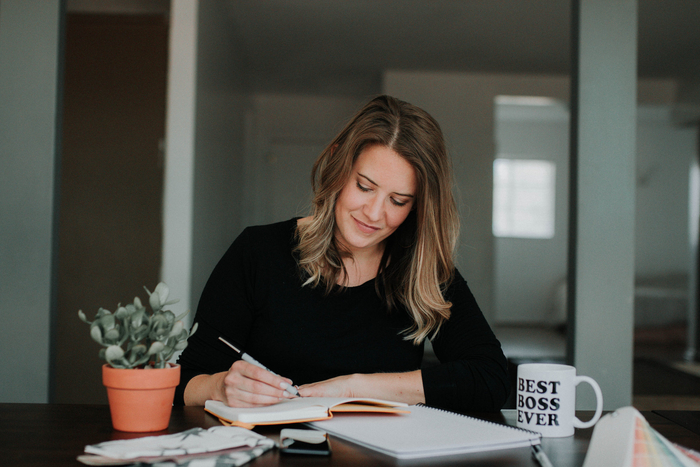How to run an interior design business when you’re a designer? Do you have to abandon client work? Is it possible without specialized education? There are so many questions and doubts. Luckily, our today’s guest knows the answers to all of them! Meet Capella Kincheloe – a renowned designer and a business coach who has helped thousands of interior designers to acquire the skills and confidence necessary to thrive in running their businesses.
Capella started her career in interior design at acclaimed Michael Smith Inc in Los Angeles. Then, she moved to Atlanta and founded her own design business. Since then, she has created countless elegant interiors for homes in Atlanta and Arizona, co-founded a professional organization, and got published in popular design magazines.
With that kind of expertise, she had all the necessary tools in her hands to help other designers grow their businesses. So, Capella started to share her knowledge through a blog, a weekly newsletter, and Zoom sessions. And for those who wish to go deeper, she created The Golden Blueprint – a training that helps interior designers to start running their businesses effectively and at more profit.
In a nutshell, Capella provides guidance and expert advice, inspires and leads through her own example. And we’re super happy that she agreed to share some tips in an interview for our architectural visualization studio! Wonder what Capella has to say about successfully running an interior design business? Read on to find out. And if you’re considering finding a coach or just need some inspiration and hands-on advice — this might be the perfect opportunity to get more info and make a wise decision.
Capella, you have a serious background and a successful career as a designer. Why did you decide to teach others?
The idea of helping other designers was something that slowly developed as I also built my own design business. After four years of working for a high-end designer on large projects in Los Angeles, I had a unique foundation to start my own practice. I am also the type that does mass amounts of research prior to making decisions. So, when I saw designers struggling, I shared what I knew and it grew from there. Also, I had a deep desire to improve the reputation of the interior design industry. And for me, that starts with the individual interior designers and getting them to run their business with confidence, clarity, transparency, and integrity.
I had a deep desire to improve the reputation of the interior design industry.
I started writing articles on my website aimed at potential design clients to educate them. Which was also really great for SEO, by the way! Those articles about the process of design were helpful for designers, and my coaching business started from there.
Which graduates of your training course are you especially proud of?

I am proud of all the graduates of The Golden Blueprint. First, they all took the step to improve their businesses and did the work. It’s not easy, since my course focuses on creating the business that each designer wants to run, not the business I think they should create or following someone else’s plan. My students dive deep into who they are as a designer and business owner. It’s a course of discovery and then trusting your instincts to create their ideal business. There is no standard in the business of design, so there is a lot of room for adaptation.
I’ve seen complete beginners start their businesses and get several clients in the duration of the course. And I’ve seen seasoned designers feel reinvigorated about their business and have confidence they’ve never had because they’re finally running the business they want. Each student has their own gain. How can I not be proud of that?
Can every designer become an entrepreneur? Or one needs some special qualities and skills?
Running a design business is not easy. The most important thing to consider about starting your own design firm is that most of your time will be spent on the business – not designing. Everything lays on your shoulders. You have to be flexible, innovative, confident. But the most important quality I see in the success of a design business owner is the belief that they can figure it out. Whatever “it” is, because every day you’re faced with a new question, issue, problem, challenge, decision – you have to have the mindset that you can figure it out. And, therefore, you do.
Does a designer always need to have a background in architecture, or education is not of utmost importance here?
I give a lot of space here for individualization. Some designers know young that they want to go into this industry. Some people need the education to help themselves feel confident. Also, some have a natural talent for business and/or design. And some designers are at different points in their lives where formal education may or may not make sense. As it is, at least in the US, designers don’t need a design degree to be a designer. There are certainly times that a degree or certification is necessary, but not always.
Working for another designer is a business education that every designer would benefit from.
Overall, there are many avenues to becoming a designer and running a design business. I do think that working for another designer is a business education that every designer would benefit from. I guess, in other words, a formal education makes sense for some but not others. However, I am a strong proponent of being a lifelong learner and seeking educational opportunities.
Where should an interior designer search for clients? How to attract them?

Clients are found everywhere! The key is knowing where to search for your ideal clients – all designers should have a specialty to help them stand out from the competition. You want to attract clients who are a good fit for the way you run your design business. So, don’t shy away from being unique and highlighting who you are as well as how you solve clients’ problems and pain points.
For example, I wasn’t a collaborative designer, but I am a researcher. So, I interviewed my clients extensively and then I would tell them that they probably wouldn’t hear from me for a couple of weeks. For some clients, this is not what they are looking for, and that’s great because we wouldn’t be a good fit and we can avoid those relationship pains. But for my ideal client – this is what they want or at least don’t mind. I spelled this out in my new client package, so new clients know what they’re getting into with me as a designer.
The best way to get new clients is to know who you are as a designer and business owner.
The more detailed you can get about knowing who you are, the more likely you’re going to attract people who like what you have to offer. On the flip side, you also should have a very specific, detailed idea of who your ideal client is. If they’re not the type to use social media, then you wouldn’t be searching for clients there. If they are the country club type, consider investing in a membership. But I think the best way to get new clients is to know who you are as a designer and business owner so your ideal clients are captivated by you.
Probably, website traffic is not the only important thing for getting new clients. What affects a potential client’s decision whether to work with a designer or not? How to turn as many website visitors as possible into clients?
A website is one of the greatest tools in any business. It’s your virtual home and used correctly can do a lot of the sales, education, and onboarding of new clients for you. And proper SEO can attract exactly the type of clients that designers are looking for. Even if most of your clients come from referrals, they’re likely to look at your website first. A well-designed website can seal the deal and educate them about your business and your design process.
We live in the information age. So, the more information you provide to clients pre-signing and set their expectations from the beginning, the smoother design projects go and the happier clients are. What you need to do is to draw in your ideal clients with your website design and copy. And for that, you really want to speak directly to your target audience and make them feel a connection to your business through your website. This way, they will be more likely to become a client. The goal is to get a prospect to feel confident and trust in your business so that they want to work with you.
Do you and your clients use 3D visualization in design projects? If so, what for?
As software improves and becomes more accessible, I see more designers using 3D visualization for their design projects, mostly in room renderings. Some clients really need those visuals to help them move forward and feel confident in the design.
I see more designers using 3D visualization for their design projects.
It can be a great sales tool because many clients have a hard time seeing how the parts come together. However, it’s important not to use 3D renders as a crutch and to make sure your clients don’t get too attached to the visualization. Because they might feel disappointed if the reality doesn’t end up looking exactly like the rendering.
Take your design presentation to a new level with interior rendering
Please give our readers some advice on how to become a successful designer as fast as possible.
Make sure that your business foundation is solid. A lot of designers start their businesses and focus on client work without giving much attention to the actual business foundation, which is making sure you have systems and processes in place that will support your business as you grow. Like when building a house, your foundation needs to be strong before you invite people in.
I recommend creating blocks of consistent CEO time. The duration may change depending on what you have going on in your business. But as long as you are committing to regularly working on your business instead of just in it, you can create a nice foundation.
Like when building a house, your business foundation needs to be strong before you invite people in.
If you’re struggling with confidence and want a blueprint to running an interior design business, I have my signature course, The Golden Blueprint. It’s a six-module business training course covering the 6 pillars of running a design business: CEO Mindset, Business Foundation, Branding, Clients, Selling Your Services, and Running Your Business. This is all my best advice from running my own business, working for others, research, and working with hundreds of designers wrapped into this one course.
We are very grateful to Capella for this interesting talk. And we wish her great success in all her projects, both as a designer and a business trainer.
Hope this interview gave you inspiration and valuable insights that will help you to run your design business! If the next time you want to read an interview of some particular expert in the architectural or interior design business, or CGI industry – write your suggestions in the comments below.
Get your project estimated in just 1 hour - fill out this brief!
Need professional 3D rendering services to showcase your designs with accuracy and impact? Then contact us at ArchiCGI. We’ll show your interior projects in beautiful hyperrealistic CG visuals that will win your clients’ hearts right away!

Catherine Paul
Content Writer, Editor at ArchiCGI
Catherine is a content writer and editor. In her articles, she explains how CGI is transforming the world of architecture and design. Outside of office, she enjoys yoga, travelling, and watching horrors.



